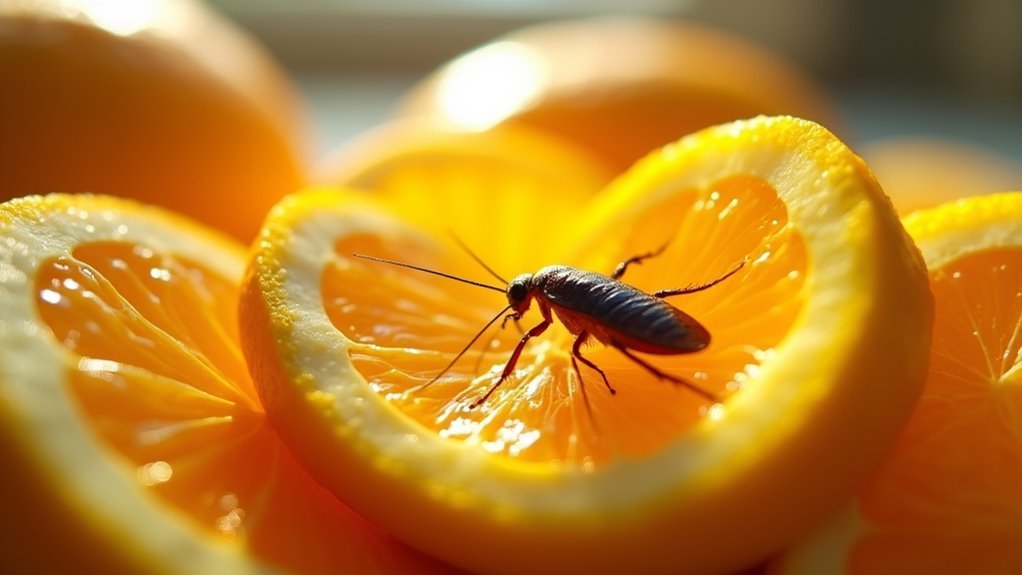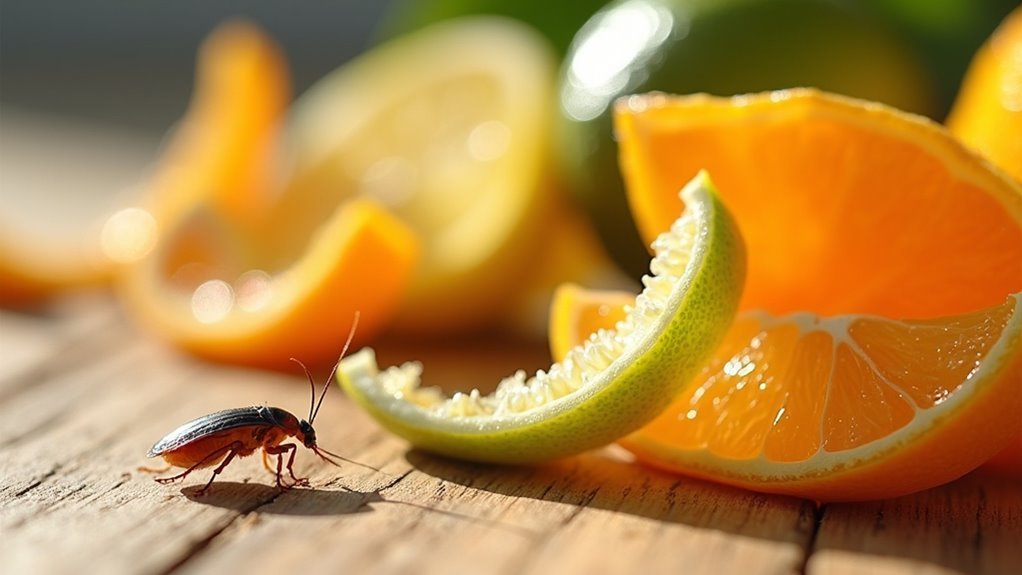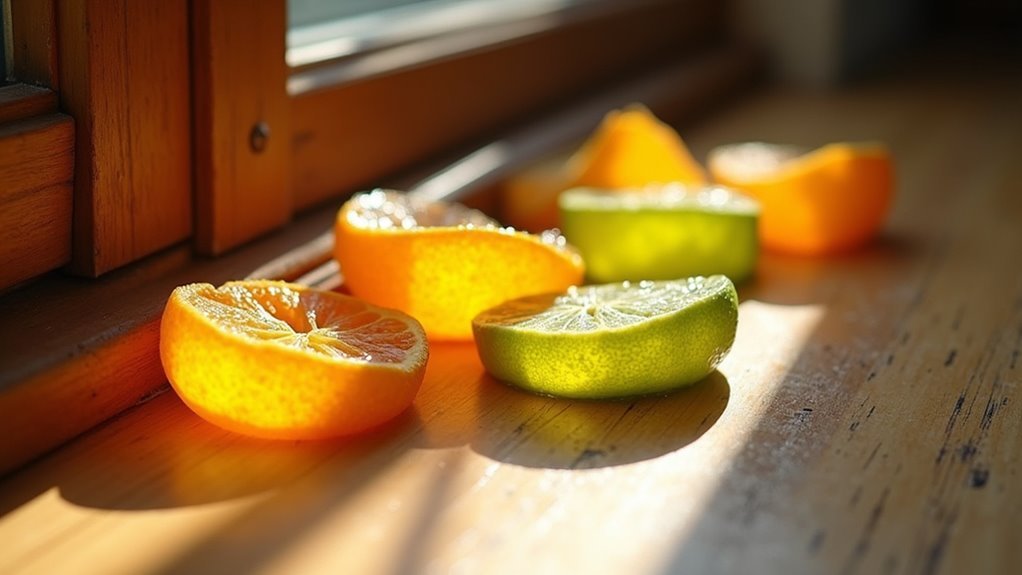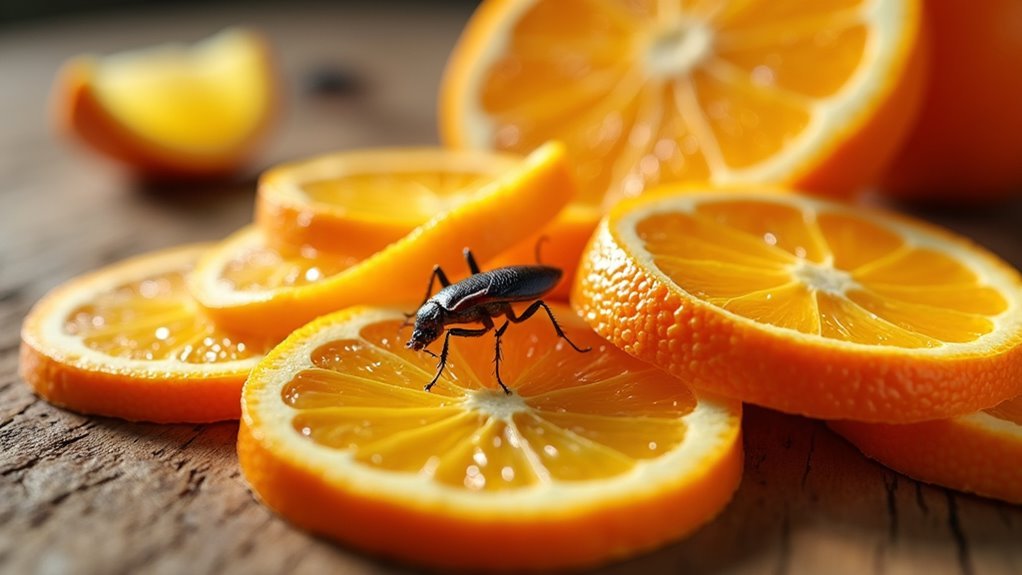Citrus peels effectively repel roaches because they contain limonene, a natural compound that overwhelms cockroaches’ sensitive olfactory receptors. When you place fresh citrus peels in roach-prone areas, the concentrated scent disrupts their sensory perception, affecting their ability to communicate, navigate, and locate food sources. This sensory overload creates an unpleasant environment that forces roaches to avoid treated zones entirely. The key lies in understanding proper preparation methods and strategic placement to maximize this natural deterrent’s effectiveness.
The Science Behind Limonene in Citrus Peels

When you peel an orange or lemon, you’re releasing limonene, a powerful natural compound that cockroaches can’t stand. This chemical creates an intense strong scent that overwhelms their highly sensitive olfactory receptors, effectively disrupting their sensory perception and forcing them to flee.
Limonene works as a natural repellent because cockroaches rely heavily on their sense of smell for navigation and survival. The concentrated oils in citrus peels emit such a potent aroma that it interferes with their ability to process environmental cues properly.
Research demonstrates this compound’s effectiveness against multiple species, including German and American cockroaches. When you expose these pests to limonene, their overwhelmed sensory systems trigger an immediate escape response, making citrus peels a scientifically-backed deterrent for pest control.
How Cockroach Sensory Systems React to Citrus Scents
Understanding limonene’s impact requires examining exactly how cockroach sensory systems process and react to citrus compounds. You’ll find that cockroaches possess incredibly sensitive olfactory receptors that can detect minute scent concentrations. When limonene from citrus peels reaches these receptors, it overwhelms their sensory perception, creating an unpleasant experience that forces them to retreat.
| Sensory Function | Normal State | Citrus Exposure |
|---|---|---|
| Scent Detection | Highly sensitive | Overwhelmed |
| Communication | Clear signals | Disrupted |
| Navigation | Precise movement | Impaired |
| Habitat Selection | Comfort-based | Avoidance behavior |
| Feeding Behavior | Normal patterns | Deterred activity |
This disruption affects their ability to communicate and navigate effectively. The strong citrus scents interfere with their environmental interactions, making treated areas unappealing. You’re fundamentally creating a natural barrier that repels cockroaches through sensory overload.
Which Citrus Peels Work Best Against Different Roach Species

Different citrus peels offer varying levels of effectiveness against specific cockroach species, making targeted selection vital for best results.
You’ll find lemon peels particularly potent against German cockroaches because their high limonene concentration disrupts these pests’ sensory perception.
Orange peels work effectively across various roach species, as their strong citrus scent naturally deters these unwanted visitors from infested areas.
For American cockroaches specifically, grapefruit peels prove highly effective since their limonene content overwhelms the roaches’ sense of smell.
You can use citrus peels from lemons, oranges, and grapefruits interchangeably, but maintaining freshness is essential.
Regular replacement enhances their repelling power, as the effectiveness diminishes when scents weaken.
Fresh peels consistently repel roaches better than dried-out alternatives.
Proper Preparation Methods for Citrus Peel Repellents
You’ll need to properly dry your citrus peels to maximize their roach-repelling power and prevent mold growth.
Once they’re dried, you must place them strategically in high-traffic roach areas like under sinks and behind appliances.
Don’t forget to replace the peels every few days to maintain that strong citrus scent that keeps roaches away.
Drying Citrus Peels Properly
While fresh citrus peels contain natural oils that roaches dislike, you’ll achieve far better results by drying citrus peels properly first.
This process concentrates the limonene compound that serves as an effective roach deterrent.
You can sun dry your peels by placing them in direct sunlight for several hours until they’re completely dried.
For faster results, use your oven at 200°F for 30-60 minutes on a baking sheet.
Complete moisture removal prevents mold while preserving potency.
Once dried, place these concentrated peels in areas where you’ve noticed roach activity.
The intensified scent will keep roaches away more effectively than fresh peels.
Remember to replace regularly to maintain their strong deterrent properties.
Strategic Placement Techniques
Now that you’ve properly dried your citrus peels, their placement determines how effectively they’ll repel roaches from your home. Focus your strategic placement in high-traffic areas where roaches commonly travel: under sinks, behind appliances, and inside kitchen cabinets.
These locations create an effective barrier that disrupts their usual pathways. You’ll need to regularly replace the peels every few days since their scent diminishes over time. Fresh peels maintain stronger repellent effects that keep roaches away.
Don’t rely solely on citrus peels—combine them with other natural deterrents like bay leaves or peppermint oil to prevent roaches from adapting to the citrus scent. This multi-layered approach, paired with proper cleaning and food storage, maximizes your success in keeping these pests out.
Replacement Timing Schedule
Since citrus peels lose their limonene potency within 2-3 days, establishing a consistent replacement timing schedule becomes essential for maintaining effective cockroach deterrence.
You’ll need to replace fresh peels every 2-3 days to maintain the strong scent of citrus that cockroaches find repulsive. Citrus fruits contain limonene, which loses its concentration rapidly once exposed to air.
Create a routine where you scatter new peels in high-traffic areas like kitchens and sinks twice weekly. Regularly replacing peels prevents roaches from adapting to diminished scents, ensuring continued effective cockroach repelling.
You can extend replacement intervals by using dried peels, which concentrate limonene content and last longer. Maintaining this schedule will keep roaches away consistently, creating an unwelcoming environment that discourages their return.
Strategic Placement of Citrus Peels in Your Home
To maximize the repellent power of citrus peels against cockroaches, you’ll need to position them strategically throughout your home’s most vulnerable areas.
Focus on high-traffic areas where roaches commonly travel, including under sinks, behind appliances, and inside cabinets where the limonene concentration will be most effective.
Target dark, damp corners where cockroaches typically hide, creating an unpleasant environment that exploits their sensitivity to strong citrus scents.
Place peels near food storage areas and garbage bins, as these locations naturally attract roaches and need the strongest deterrent presence.
For best results, scatter citrus peels throughout multiple zones simultaneously rather than concentrating them in just one area.
This thorough strategic placement guarantees you’re blocking roaches’ preferred pathways and hideouts while maintaining consistent repel roaches coverage throughout your home.
Creating Citrus Peel Barrier Zones Around Entry Points

While strategic interior placement forms the foundation of citrus pest control, establishing defensive perimeters around your home’s entry points creates the most critical line of defense against invading cockroaches.
You’ll want to scatter fresh or dried citrus peels around doors, windows, and cracks where roaches typically enter. These barrier zones work because limonene in the peels disrupts cockroaches’ olfactory receptors, making treated areas unappealing.
Replace your peels every few days to maintain their potent scent and repel roaches effectively. Combine citrus peels with essential oils and consistent cleanliness practices to strengthen your defensive perimeter.
Monitor and refresh peel placement regularly to prevent roaches from adapting to the citrus aroma.
Combining Citrus Peels With Other Natural Deterrents
Although citrus peels provide effective solo protection against cockroaches, you’ll achieve superior results by combining them with complementary natural deterrents that target different sensory pathways.
Mix essential oils like peppermint or eucalyptus with your citrus peels to disrupt roach navigation and respiratory functions. You can also pair peels with bay leaves in cabinets and pantries for multi-layered protection.
Essential oils like peppermint and eucalyptus enhance citrus peels by targeting roach navigation systems through multiple sensory disruption pathways.
Create powerful natural solutions by mixing dried citrus peels with cayenne pepper powder—the capsaicin irritates roaches while amplifying citrus effects.
Adding crushed garlic introduces sulfur compounds that overwhelm cockroach senses alongside citrus aromas. These combinations help repel cockroaches more effectively than single ingredients alone.
Remember to refresh your deterrent mixtures regularly, as scent potency diminishes over time and consistent maintenance guarantees continued effectiveness.
How Long Citrus Peels Remain Effective as Repellents
Understanding the lifespan of citrus peels as cockroach deterrents helps you maintain consistent protection in your home. Fresh citrus peels effectively repel roaches for 3 to 7 days before losing their potency. The limonene compound responsible for the strong aroma degrades quickly when exposed to air, diminishing the peels’ repellent ability.
You’ll need to replace citrus peels every few days to maintain effective cockroach control. Environmental factors accelerate this process – humidity and warm temperatures cause faster scent degradation.
Don’t wait until the aroma completely disappears; proactive replacement guarantees continuous protection.
For best results, combine regular citrus peel replacement with other pest control methods. This consistent approach maximizes your natural deterrent strategy, keeping cockroaches away from your living spaces through sustained citrus effectiveness.
Signs That Your Citrus Peel Method Is Working
Since you’ve placed citrus peels strategically around your home, you’ll want to recognize the telltale signs that your natural repellent strategy is actually working.
The strong scent from citrus peels should produce noticeable changes in roach activity patterns.
The potent citrus aroma disrupts cockroach movement patterns, creating detectable behavioral changes that signal your natural deterrent is effectively working.
Here’s what indicates successful deterring roaches:
- Decreased visual sightings – You’ll notice fewer roaches in areas where you’ve positioned citrus peels, especially during nighttime hours when they’re typically most active.
- Reduced droppings and egg casings – Areas near citrus peels show considerably fewer signs of roach presence, proving the method is unappealing to cockroaches.
- Behavioral shifts – Roaches actively avoid citrus-treated zones, changing their usual travel routes.
- Maintained peel integrity – Your citrus peels remain undisturbed, indicating roaches aren’t approaching to repel roaches effectively.
Common Mistakes When Using Citrus Peels for Roach Control
While recognizing success indicators helps you track progress, many homeowners sabotage their citrus peel strategy through preventable errors that reduce effectiveness or create new problems.
The most critical common mistakes involve neglecting to replace peels once their scent fades, which drastically reduces the repellent’s power.
You’ll also encounter problems if you scatter peels without using cleaning products first, creating messy conditions that attract other pests.
Don’t rely on citrus peels as a standalone solution for large infestations—they work best alongside extensive pest control methods.
Additionally, using undried peels promotes mold growth that actually attracts roaches, while overusing peels in concentrated areas causes roaches to adapt, making your repellent ineffective.
Maximizing Potency Through Fresh Peel Rotation
To maintain maximum deterrent power against cockroaches, you must establish a systematic rotation schedule that replaces citrus peels every 48-72 hours before their limonene concentration drops greatly.
Fresh peels deliver potent citrus aroma that overwhelms cockroaches’ sensitive olfactory receptors, creating an unwelcoming environment that reduces cockroach activity considerably.
Strategic Rotation Guidelines:
- Focus placement in high-traffic areas like kitchen counters, under sinks, and behind appliances where roaches commonly travel.
- Alternate citrus types between lemons, oranges, and grapefruits to prevent adaptation to single scents.
- Replace peels immediately when they begin drying or losing their strong fragrance.
- Layer multiple peel types simultaneously to create complex scent barriers that enhance repellent properties.
This systematic approach guarantees consistent limonene levels that maintain ideal deterrent effectiveness against persistent roach populations.
When to Upgrade From Citrus Peels to Professional Treatment
Although citrus peels offer an eco-friendly first line of defense, you’ll need to recognize when this natural approach isn’t sufficient for your cockroach problem.
If you’re noticing persistent cockroach activity across multiple rooms despite consistent citrus peel placement, you’re likely dealing with a larger infestation.
When roaches start adapting to the citrus aroma or showing reduced sensitivity, repelling roaches becomes increasingly difficult.
Professional pest control services can assess your situation’s severity and provide targeted treatments that citrus peels alone can’t match.
If you’re experiencing recurring problems after initial natural treatment success, it’s time to eliminate the issue permanently by consulting professionals who’ll identify and address the root cause.
Frequently Asked Questions
Do Citrus Peels Repel Cockroaches?
Yes, citrus peels repel cockroaches effectively. You’ll find they contain limonene, which overwhelms roaches’ smell receptors. Place fresh peels where you’ve seen roach activity, but you’ll need to replace them regularly for continued effectiveness.
Does Lemon Peel Keep Roaches Away?
Yes, lemon peels keep roaches away because they contain limonene, which produces a strong citrus scent that overwhelms cockroaches’ olfactory receptors. You’ll find they’re effective, non-toxic deterrents when placed strategically.
How Do You Make Citrus Spray for Roaches?
You’ll combine one cup water with fresh lemon or orange juice, add citrus essential oil drops, pour into a spray bottle, shake well, then spray around kitchens, sinks, and roach entry points regularly.
Why Do Roaches Hate Citrus?
Roaches hate citrus because you’re overwhelming their sensitive smell receptors with limonene, a natural compound in citrus peels. This strong scent disrupts their sensory perception and creates an environment they can’t tolerate.
In Summary
You now understand how limonene disrupts roaches’ sensory systems and which citrus peels work best for your situation. You’ve learned proper preparation techniques, strategic placement methods, and how to rotate fresh peels for maximum effectiveness. You can recognize when your citrus approach is working and avoid common mistakes. Remember, if you’re still seeing significant roach activity after consistent citrus treatment, it’s time to contemplate professional intervention for complete control.





Leave a Reply